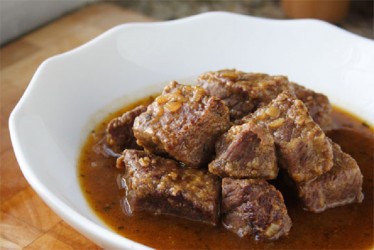Making a stew out of the many cuts of beef that lend themselves to long, low, slow cooking is one of the most delicious things to eat. Unlike cooking a steak, you never have to worry about internal temperature and getting it to that perfect rare, medium rare, medium, or medium well. With a stew, it is all about well done. Well done until the meat is tender, soft and can be cut with a spoon. If there are bones, the meat should fall away easily.
With stews, fat is your friend, it provides much needed moisture for the meat and adds immense flavour to the gravy/sauce of the stew. Do not shy away from beef to make stew that has in a combination fat, tissues and bones, they are preferred rather than abhorred when it comes to making stews.
There are some boneless cuts of beef, however, that work well for stews. Each market labels their cuts differently; therefore, rather than get all caught up with labels, use your eyes to guide you. Choose beef that has marbling, (lines of fat running through it,) they are going to melt during the long cooking process and keep the meat moist and tender. Like I said before, you can also choose cuts that have in bones such as the ribs. Another great part for stewing is the beef shanks. It is my preferred cut for Pepperpot.

(Photo by Cynthia Nelson)
Beef shank is the leg portion that has the bone in the middle with the meat around it. The meat on the outside does not have much fat but it does have lines of connective tissue, collagen. When these break down during long cooking, they render the meat fork tender. And the marrow from the bones gives an unrivaled depth of meaty beefy flavour to the stew. Try it – you won’t be disappointed.
For this recipe I used chuck shoulder roast.
INGREDIENTS
- 2 pounds of beef (for stew)
- Salt and pepper to taste
- All-purpose flour
- 3 – 4 tablespoons vegetable oil
- 1 cup finely minced onions
- 1 bouquet garni (see notes below)
- Hot water
DIRECTIONS
- Cut the meat into large cubes.
- Season with salt and pepper and set aside.
- Heat oil in a deep pot or pan over medium until oil is very hot but not smoking.
- Working in batches (depending on the width of your pan/pot), brown the beef on at least 2 sides. When all the beef is browned, add more oil to the pan if necessary, you want to have at least 3 tablespoons of oil.
- Add the onions along with a little salt and use a wooden or hard plastic spoon to scrape the bottom of the pan to remove any stuck on bits and to cook it with the onions. Let the onions cook for 3 – 4 minutes.
- Add the beef and any liquid from its resting back to the pot with the onions; give a good stir.
- Add enough water to reach the top of the beef but not cover it completely, along with the bouquet garni, stir the pot, cover and bring to a boil. When the pot comes to a boil, reduce the heat to low and cook for 50 minutes – 1 hour, or until tender. Remove the lid, raise the heat to high and let the stew cook down to your desired consistency for sauce/gravy. Taste for seasoning (salt) and adjust if necessary. Let the stew sit for 20 – 30 minutes before serving (remove the bouquet garni before serving).
NOTES
- A bouquet garni is a bundle of fresh aromatic herbs tied together and added to stews, soups, broths and stocks to impart flavour. To make one for this recipe, tie together a few stems of thyme, a bay leaf and a couple stalks of celery. Use kitchen string to tie them or if you have, wrap and tie them in a piece of cheesecloth.
- Beef shrinks when cooked so cut the meat larger so that by the time it is finished cooking it is the serving size you are looking for.
- If you like, add some type of browning to the stew.
- The cooking time would vary depending on the quantity of meat, the cut of the meat and the type of heat. Bone-in meat takes longer to cook.
- If using a pressure cooker, cook for 25 minutes on low heat after the pressure cooker comes to full pressure first. Again, the time will vary depending on the type and brand of pressure cooker you have. Once cooked, open the cooker and let the liquid reduce to the consistency you want.
- Potatoes, carrots, fresh/frozen green peas and dumplings can all be added to the stew. If adding potatoes, do so half way through the cooking process, peas can be added later as well as the dumplings as they take less time to cook. These are only suggestions and are based on if you are cooking with a regular pot. If using a pressure cooker, add the potatoes and peas after pressuring the beef.




